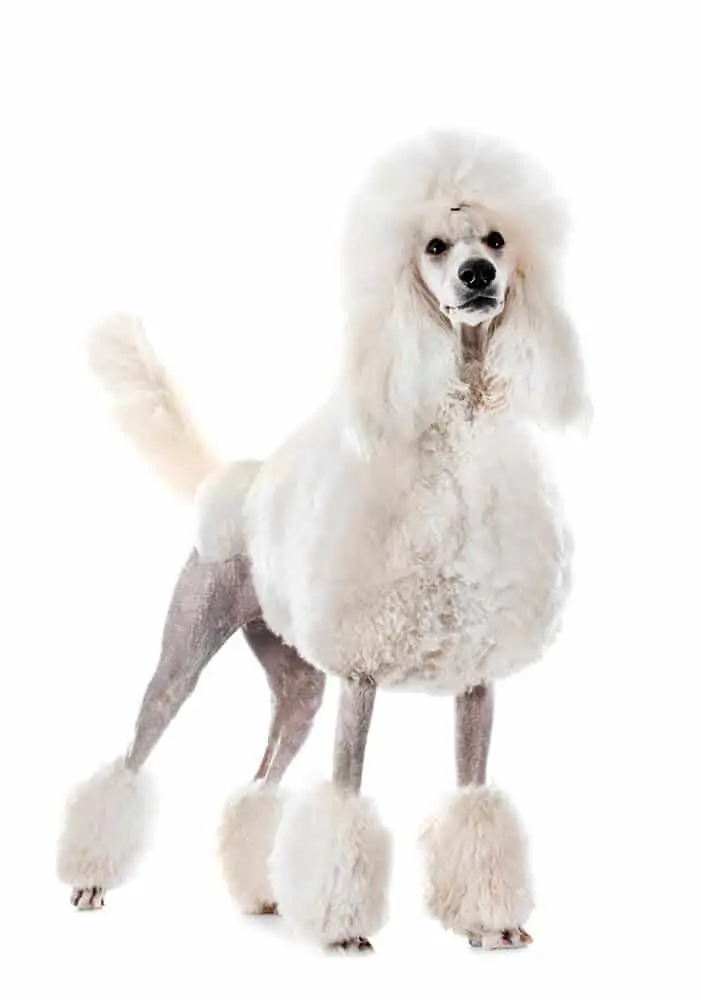Last Updated on
The first time I saw a Saint Berdoodle was while I was out walking my Sheepadoodle and Labradoodle. He was a big fella with a curly black coat and a sweet demeanor.
And boy, was he big!
His owner told me he was 8 months old and he was a good 12 inches taller than both my dogs.
If you’ve ever wondered what a Saint Berdoodle is like, then this article is for you.
Today, we’re diving into this unique dog breed to understand their personalities and temperaments.
Grab your leashes and treats, let’s get to it!
What is a Saint Berdoodle?
Whether you call them a Saint Berpoo or St. Berdoodle, this loveable pal is a designer mixed breed dog coming from a St Bernard and, for all you detectives out there I’m sure you deduced, a Standard Poodle.
St Bernard’s and Poodles have been wagging their tails around the U.S. since about 1880. Although there isn’t a huge amount of records kept with the Saint Berdoodle history, it is evident that the watchful and strong characteristics of the Saint Bernard and the intelligence of the Poodle were quite the ambitious match to create a beautiful family dog.
Saint Berdoodle coat
Just like the lottery ticket, a set of parents draw when they try for a bundle of joy of their own, it can be left to a 50/50 chance depending on what appearance the parents have. But there are some common outcomes we can break down for a Saint Berdoodle.
Saint Berdoodles typically have a medium-length coat with a bit of a wavey look. And the texture can be tossed up between wiry and smooth depending on its parents; but no matter the texture, we know it’ll love to cuddle and play all the same!
Along with the texture, their color can also fluctuate between:
- White and black
- White and brown
- Red and white
- White and red
These fellas are known for their high-maintenance coats. You’ll need to invest in a good brush and set aside time each day to brush and comb the hair of your Saint Berdoodle, otherwise, they’ll get painful mats! If you don’t want to partake in daily brushing, you can find a groomer to help out. Typically, you’ll need to send your Saint Berdoodle to the groomers every six to eight weeks if you aren’t doing daily brushings.
As far as shedding goes, there isn’t much. Phew! You can take the lint rollers out of your shopping cart!
As for that cute puppy face we all know and love, Saint Berdoodles usually have eyes somewhere on the brown spectrum and their cute noses can be black or brown.
Saint Berdoodle size
Saint Berdoodle dogs are fairly big, I mean check out their parents, talk about height show-offs am I right?
All jokes aside, here are the average heights and weights of both males and females for these loving large family dogs:
- Average male size: 27-30 inches, 150-200 pounds
- Average female size: 24-27 inches, 110-160 pounds
Just be sure if you have little ones around to keep an eye on them around these goofy giants. Though Saint Berdoodles are great with all ages and families, a big dog can unintentionally knock little ones over.
Saint Berdoodle personality and temperament
Of course, we love to admire and cozy up to adorable dogs. We’ve all scrolled through the #cutedoggo hashtag and awwww’ed over the cute dogs on the other end.
But looks aren’t everything, how about that delightful personality? This is where we’ll start to look at the St Bernard and Poodle sides separately and then circle back to the Saint Berdoodle; because with its personality and temperate it really depends on who the pup took after more in the genetic swap. Without further ado, let’s meet the parents!
Saint Bernard

- Big softie with the family: absolutely affectionate and great with all ages, they didn’t make those Beethoven movies for nothing!
- Enjoys other pets: they wouldn’t ask you for another dog to be around, but if they were around other pets, they wouldn’t mind.
- Good guarding: Saint Bernards are friendly and open to meeting new people, but if something looks fishy they are all eyes and ears, only really barking in response to alert. Playtime is welcomed though!
- Trainable: training can vary from dog to dog, with patience, they can learn. Their energy levels are pretty normal; they like to keep things moving.
Poodle

- Loves all family memebers: perfect with children and super-duper loving to everyone they encounter, whatta dog!
- Enjoys other family pets: the Poodle can get behind the Saint Bernards. They don’t mind having other pets around but they also don’t mind getting 100% of your attention either.
- Good at guarding: these very aware canines are always ready to be on alert they are very vocal about that. But if there’s a ball in the room it’s game over; fetch time is all the time! Poodles love to play and have the energy stocked up for it.
- Highly trainable and intelligent: Poodles are highly intelligent, therefore they must have something productive to do with their free time, the great side to that is they are very receptive to training.
Saint Berdoodle’s Personality
My goodness, what a combo of greatness; when there’s a Saint Berdoodle in your midst you have quite the warmhearted, patient, kind, mellow, active, smart cookie on your hands! They also do good with other dogs, they’re the ultimate friend with how caring and playful their nature is.
If you are lucky enough to adopt a Saint Berdoodle as a puppy, there are some extra vital specifics to keep in mind.
It’s important that they are socialized with other dogs, whether that’s a playdate with a friend’s pet or chilling with some cool local dogs at the park, receiving this at a young age will help them be more playful and compatible with other dogs/pets as it gets older.
The installation of exercise at a young pup age is also very important, walking with your dog often and having outside playtime will show them that exercise is valuable and will keep them healthy and happy. At the same time, you’re getting those benefits too, it’s a win-win!
Just be mindful not to exercise your pet too much when they’re too young. As their bones are still growing, you can’t overdo it. This article will help you understand how much exercise is too much.
Being that Saint Berdoodles are part Poodle, they are also easy to train!
When opening your arms and door to this incredibly devoted and lovely dog, please be sure to go ready to have a loyal companion. This furry fella is going to want his paws involved in anything and everything that has to do with its beloved family!
Saint Berdoodle’s Energy Levels
This happy-go-lucky pup runs on about a medium, or average, amount of energy, but this also depends once again on which breed parent it is more like.
If it is more Poodle, it will require a little more activity and physical attention from its loving owner. And if it takes more after the Saint Bernard, it will still require that healthy amount of exercise and movement but its owner may need to keep in mind that with its size, it may need to take some time-outs during the day; that just means more naps and cuddles!
Exercises can range from playing out in the yard, taking a walk, or even combining both and going to a dog park!
With whichever you decide, a Saint Berdoodle should receive at least 60 minutes of daily exercise and roughly 8 miles of walking per week.
How much is a Saint Berdoodle?
The price range for a Saint Berdoodle can fluctuate a bit, depending on the breeder or adoption agency you choose. Please make sure you do your research in knowing the puppy is being brought into the world through a safe and loving place. AKA, not a puppy mill, no puppy deserves that. But regardless you should expect a large budget for your large future dog.
Saint Berdoodles can be adopted from anywhere between $1,000-$4,000 dollars.
This range depends on the color of the pup’s coat; white-black coats are a little less expensive than multi-color coats. And depending on what kind of family tree the pup’s parents came from; best in show dogs, or a very healthy bloodline. Ultimately, the price really depends on who you are adopting through, be sure to look at a few different options and weigh out the best one to find your new buddy.
A rescue adoption is always an option and an amazing one at that. There are many beautiful, loving, and deserving dogs that would be so thankful and joyous to have a loving home. If you and your household can consider the route of rescuing, you can browse our list of Doodle dog rescues. Your next fuzzy family member could be patiently waiting for you!
Health & Life Span
With any dog breed, you may receive some health concerns to be aware of and watch out for.
This doesn’t mean every single thing on this list will happen, they are simply things you should be conscious of and know are a potential possibility going into adopting and caring for a Saint Berdoodle.
Don’t let that overwhelm or scare you though, we’ll break it down thoroughly and simply for you.
Below is a list of the potential health problems this breed can experience, based on common health issues of Saint Bernards and Standard Poodles:
- Distichiasis: is a condition where more hair than usual grows out of the eyelash area. This can be treated with surgery and would require healing time around the eyes.
- Gastric Torsion: when a dog’s stomach is filled with too much gas (bloating) it can become twisted and cause life-threatening problems. Making sure your pup isn’t playing right after they eat can help reduce the chances of gastric torsion.
- Elbow Dysplasia: when the elbow of the dog has an abnormality. This can potentially cause arthritis and pain for the pup, but can possibly be treated at home with weight control and proper/appropriate exercise, and in extreme cases, surgery may be required.
- Sebaceous Adenitis: sebaceous glands are found within the dog’s skin and provide oil to their coats, this condition is where these glands become inflamed. Primarily this can be genetic, and it can be treated with vet prescribed supplements, medication, or in an extreme case topical treatment.
- Hip Dysplasia: this condition is when the hip joint and its socket are not matching up properly, not fitting as they should, and as a result, they deteriorate over time. Warning signs include not moving their legs around as much, a noticeable decrease in muscle, swaying, and a decrease in activity.
- Heart Conditions: there are two heart diseases most common in dogs. First is Valve Disease, which is when a heart murmur develops due to blood not following correctly. The second is Heart Muscle Disease, which is when the muscles in the dog’s heart begin to wear down making it difficult for the heart to pump blood. Catching early signs is vital with heart conditions, some signs are fatigue when playing and walking, difficulty breathing and coughing, weakness and collapsing, and bloating of the belly.
- Addison’s Disease: this disease is especially mysterious because there isn’t an exact known cause and the symptoms can vary from dog to dog. Some common symptoms of this disease are experiences of a stomach virus, loss of appetite, poor functioning of kidneys, affecting important muscle tissues, and inability to deal with stress/anxiety. Sadly this disease is not curable, but it is treatable.
- Entropion: this occurs when the eyelid doesn’t sit properly and instead rolls in towards the eyeball; causing irritation, pain, and can even lead to ulcers and vision problems.
- Corneal Dystrophy: this condition can appear without pain, though sometimes it may occur with it, in a dog’s eye and begin to make it appear cloudy. Sometimes this condition can be treated by a specialist but is also at times left alone due to the fact that it doesn’t always obstruct the dog’s vision.
- Ear infections: these are common with Poodles and doodle mixed breed dogs. To avoid ear infections, make sure to clear the Saint Berdoodle’s ear regularly.
When you have the privilege of loving and caring for someone you’ll always make time and energy to be sure they are receiving the healthy food they need, exercise they require, the attention they deserve, and regular check-ups for their safety and well-being.
Simply educating yourself with this knowledge and knowing it’s a possibility is a perfect tool to have in your doggy parent toolbelt; no need to be paranoid or overwhelmed, just aware and prepared. Keep your vet close, and your pup closer.
Saint Berdoodle Expected life span
Being the big dogs that they are, Saint Bernard’s tend to have shorter lifespans and only live around 8-10 years. A Standard Poodle can live anywhere from 12-15 years.
That being said, with a thriving loving home, proper food and care, lots of playtime, walks, and love, the expected average life span for a Saint Berdoodle is 10-12 years.
Why you shouldn’t get a Saint Berdoodle
We’ve talked about how great the Saint Berdoodle dog is, but there are a few reasons why you might not want to get this dog breed:
- They require lots of grooming: being large dogs, grooming a Saint Berdoodle is a lot of work. If you don’t want to partake in daily brushings or pay for monthly grooming, a dog that doesn’t require as much grooming may be a better fit.
- They need a moderate amount of exercise: although giant dog breeds are known for being slightly lazy, this isn’t the case with Saint Berdoodles. Being part Standard Poodle, these dogs need a moderate level of exercise. If you’re looking for a couch potato, this dog isn’t it.
Why a Saint Berdoodle?
If your household is looking for a dog that is extremely family-oriented and friendly, will stick by your side no matter what, give you cuddles galore, shower you with loyalty and affection, make you laugh, and keep you on your toes with how gosh darn smart they are, then you have found all you’d want and even more with the fabulously marvelous Saint Berdoodle.
This article may include affiliate links. www.travellingwithadog.com is a participant of Amazon.com Services LLC Associates Program. As an Amazon Associate, I earn a commission from qualifying purchase. www.travellingwithadog.com participates in other affiliate programs, and recieves commissions when purchases are made through the links. The cost is not inflated to account for the commission earned.
Veterinary Disclaimer: travellingwithadog.com is not a substitute for veterinary advice and does not intend to provide any type of veterinary advice for your animals. Please consult your vet for any questions you have regarding your pets health.

About the Author:
Dana owns a Sheepadoodle and a rescue merle Labradoodle. Her first dog growing up was a white Toy Poodle and she’s loved dogs ever since. She has years of experience fostering dogs and has helped find homes for a variety of different breeds, both large and small! After seeing so many dogs end up unwanted and in shelters, she began blogging about different dog breeds (specifically Doodle dogs, since that’s what she knows best) to help people make informed choices when adding a new member to their family.
When Dana’s not brushing her Doodles’ hair (it takes a lot of time for two!) you can find her playing nose work games and fetch with her two amazing pups.
Learn more about her here.

